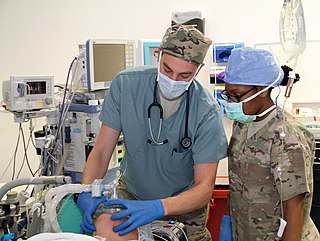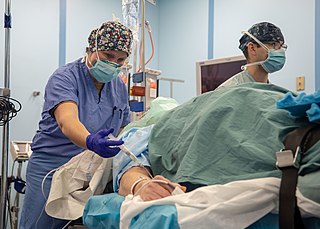
General anaesthesia (UK) or general anesthesia (US) is a method of medically inducing loss of consciousness that renders a patient unarousable even with painful stimuli. This effect is achieved by administering either intravenous or inhalational general anaesthetic medications, which often act in combination with an analgesic and neuromuscular blocking agent. Spontaneous ventilation is often inadequate during the procedure and intervention is often necessary to protect the airway. General anaesthesia is generally performed in an operating theater to allow surgical procedures that would otherwise be intolerably painful for a patient, or in an intensive care unit or emergency department to facilitate endotracheal intubation and mechanical ventilation in critically ill patients. Depending on the procedure, general anaesthesia may be optional or required. Regardless of whether a patient may prefer to be unconscious or not, certain pain stimuli could result in involuntary responses from the patient that may make an operation extremely difficult. Thus, for many procedures, general anaesthesia is required from a practical perspective.

Anesthesiology, anaesthesiology or anaesthesia is the medical specialty concerned with the total perioperative care of patients before, during and after surgery. It encompasses anesthesia, intensive care medicine, critical emergency medicine, and pain medicine. A physician specialized in anesthesiology is called an anesthesiologist, anaesthesiologist, or anaesthetist, depending on the country. In some countries, the terms are synonymous, while in other countries, they refer to different positions and anesthetist is only used for non-physicians, such as nurse anesthetists.

A nurse anesthetist is an advanced practice nurse who administers anesthesia for surgery or other medical procedures. Nurse anesthetists (NA's) administer or participate in administration of anesthesia services in 107 countries, working with or without anesthesiologists. Because of different historical backgrounds, anesthetist responsibilities and roles vary widely between countries. Depending on the locality, their role may be limited to intraoperative care during anesthesia itself or may also extend before and after. The International Federation of Nurse Anesthetists was established in 1989 as a forum for developing standards of education, practice, and a code of ethics.

David Morritz de Kretser is an Australian medical researcher who served as the 27th Governor of Victoria, from 2006 to 2011.

The British Journal of Anaesthesia is a monthly peer-reviewed medical journal published by Elsevier on behalf of the Royal College of Anaesthetists, the College of Anaesthesiologists of Ireland, and the Hong Kong College of Anaesthesiologists, for all of which it serves as their official journal.

Stephen Nicholas Cluley Bolsin is a British anaesthetist whose actions as a whistleblower exposed incompetent paediatric cardiac surgery at the Bristol Royal Infirmary leading to the implementation of clinical governance reforms in the United Kingdom.
Neurosurgical anesthesiology, neuroanesthesiology, or neurological anesthesiology is a subspecialty of anesthesiology devoted to the total perioperative care of patients before, during, and after neurological surgeries, including surgeries of the central (CNS) and peripheral nervous systems (PNS). The field has undergone extensive development since the 1960s correlating with the ability to measure intracranial pressure (ICP), cerebral blood flow (CBF), and cerebral metabolic rate (CMR).
Geoffrey Kaye (1903–1986) was an Australian anaesthetist.
The following outline is provided as an overview of and topical guide to anesthesia:
The College of Intensive Care Medicine (CICM), also known by its longer and more complete name, the College of Intensive Care Medicine of Australia and New Zealand, is the medical specialty college statutorily responsible for the training and accreditation of intensive care medical specialists in Australia and New Zealand.
Eye injuries during general anaesthesia are reasonably common if care is not taken to prevent them.
Chi Ho Ban Tsui is a Canadian anesthesiologist known for medical innovation in the field of anesthesia. Examples include describing the Tsui Test and developing the StimuLong Sono-Tsui for ease of pediatric epidural placement. Recently along with his son, Dr. Jonathan Jenkin Tsui, Dr. Tsui developed a catheter-over-needle kit allowing a continuous catheter placement to be performed with the ease of a single shot during peripheral nerve blocks.
Nicholas Peter Franks FRS FRSB has been Professor of Biophysics and Anaesthetics at Imperial College London since 1993. His research focuses on how general anaesthetics act at the cell and molecular levels as well as with neuronal networks. Franks holds patents on use of xenon gas as a neuroprotectant and has published research on the use of the anesthetic properties of xenon.
Gordon Jackson Rees was a British anesthesiologist, recognized as a pioneer in pediatric anesthesia.
Teresa (Tess) Rita O'Rourke Cramond AO, OBE (1926-2015) was an Australian doctor and the director of the Multidisciplinary Pain Centre at the Royal Brisbane Hospital. Her career spanning fifty years, was dedicated to improving the use of anaesthesia, resuscitation and pain medicine, with specific reference to the relief of cancer pain and palliative care.

Rachelle Buchbinder is an Australian rheumatologist and clinical epidemiologist. Her clinical practice is in conjunction with research involving multidisciplinary projects relating to arthritis and musculoskeletal conditions. She promotes improvement of communication with patients and health literacy in the community.
Mike Grocott is professor of anaesthesia and critical care medicine at the University of Southampton and director of the National Institute for Health and Care Research's (NIHR) Southampton Biomedical Research Centre (2022-27). He is an NIHR Senior Investigator (2018-26) and was national specialty group lead for Anaesthesia Perioperative Medicine and Pain within the NIHR Clinical Research Network (2015-2021). He is a consultant in critical care medicine at University Hospital Southampton NHS Foundation Trust.
The American College of Veterinary Anesthesia and Analgesia (ACVAA) is one of 22 veterinary specialist organizations recognized by the American Veterinary Medical Association.

Vanessa Shona Beavis is a New Zealand anaesthesiologist and honorary senior lecturer of the University of Auckland. From 2020 to 2022, Beavis was president of the Australian and New Zealand College of Anaesthetists (ANZCA).
Amanda Baric is an Australian anaesthesiologist. She has been key to the Australian collaboration with Mongolia to develop training courses for anaesthesiologists for which work, she was awarded the Order of the Polar Star of Mongolia. This work has also extended to Myanmar.







